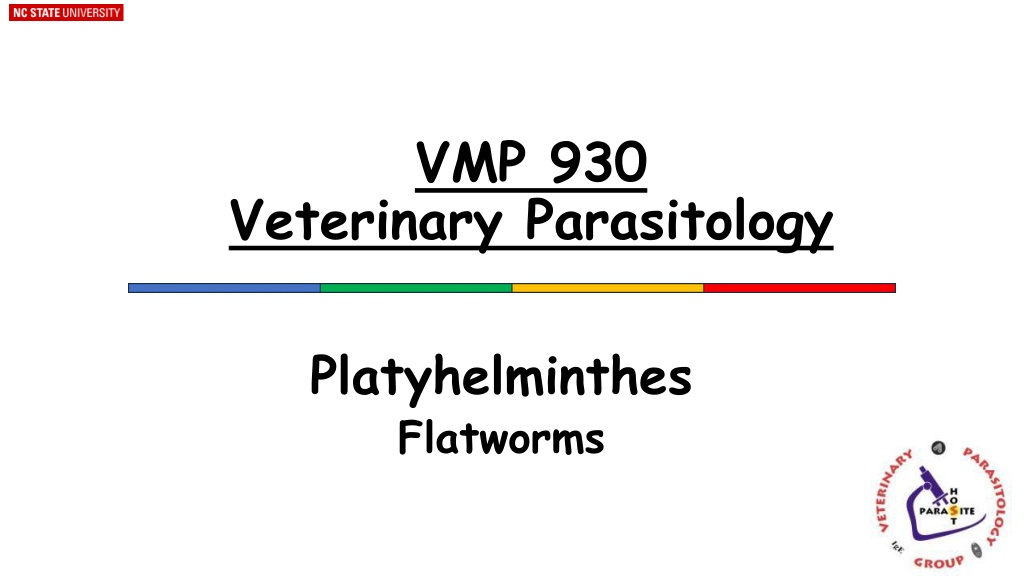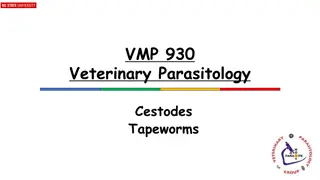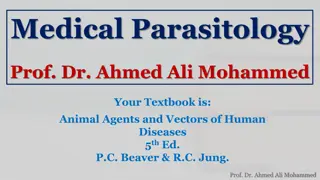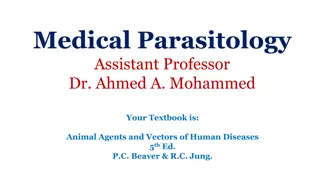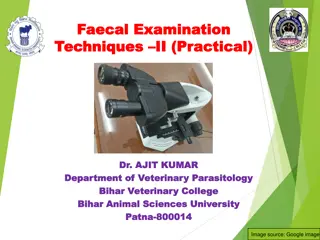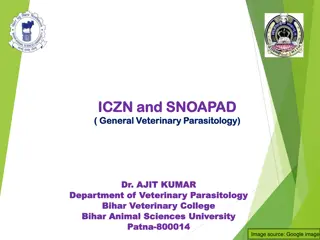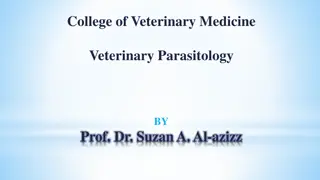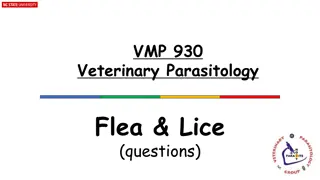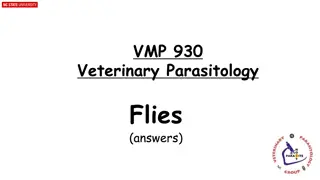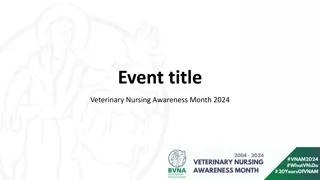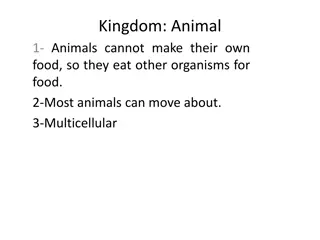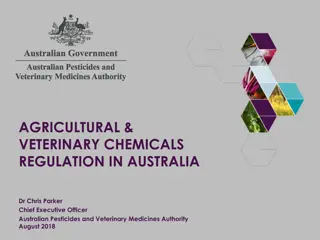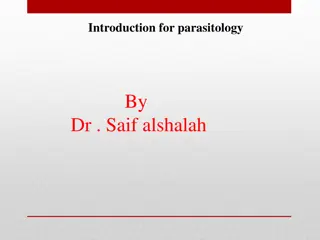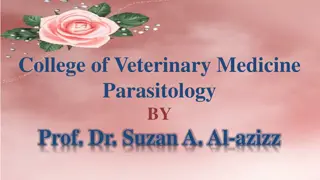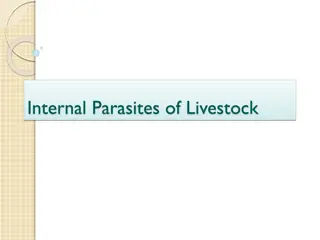Understanding Flatworms and Roundworms in Veterinary Parasitology
This comprehensive content explores the world of flatworms and roundworms in veterinary parasitology. It covers various classes such as Turbellaria, Monogenea, Trematoda, and Cestoda, detailing their characteristics, importance in veterinary medicine, and complex life cycles. The content touches on specific species like Bipalium, Gyrodactylus, Fasciola, and Taenia, shedding light on their roles as parasites in different hosts. Illustrated with informative images, this material provides valuable insights into these fascinating yet potentially detrimental organisms.
Uploaded on Jul 02, 2024 | 1 Views
Download Presentation

Please find below an Image/Link to download the presentation.
The content on the website is provided AS IS for your information and personal use only. It may not be sold, licensed, or shared on other websites without obtaining consent from the author. Download presentation by click this link. If you encounter any issues during the download, it is possible that the publisher has removed the file from their server.
E N D
Presentation Transcript
VMP 930 Veterinary Parasitology Platyhelminthes Flatworms
Nematoda Platyhelminthes v/s A A B B C D D C Roundworm (N) ? OR Flatworm (P) ? P Blood Flukes (dioecious exception) P Taenia P Fascioloides N Dioctophyme N Ascaris (from 14-year-old)
Platyhelminthes Groups Class Turbellaria = Planarians Class Monogenea = Monogeneans Class Trematoda = Flukes Subclass Aspidogastrea Subclass Digenea Class Cestoda = Tapeworms
Class Turbellaria Planarians Free-living Flatworms Bipalium (Hammerhead worm) a pseudoparasite Freshwater Flatworms Land Flatworms Marine Flatworms
Veterinary Importance Class Monogenea Gyrodactylus sp. Polystomum sp. Benedinia sp. Ecto-Parasites of Fish Monogenetic flukes
Aspidogaster sp. Cotylogaster sp. Lobatostoma sp. Ecto-Parasites of Mollusks, Fish, Reptiles Class Trematoda Subclass Aspidogastrea
Class Trematoda Subclass Digenea Veterinary Importance Endo-Parasites of Vertebrates Fasciola sp. Paragonimus sp. Heterobilharzia sp. Digenetic flukes
Taenia sp. Dipylidium sp. Anoplocephala sp. Veterinary Importance Class Cestoda Tapeworms
Digenetic Trematodes Digenea(di = two), (genea = beginnings) a. Sexual Reproduction => Adult worms in definitive host b. Asexual Reproduction => Larval worms in snail host Morphology 1. General Flatworm Characteristics 2. Suckers and/or holdfast organs 3. Incomplete gut 4. Reproductive organs (testes, ovary, vitellaria)
Digenetic Trematodes Complex Life Cycle 1. Definitive Host a. Adult Worms (Sexual Reproduction) 2. Environment a. Ovum (Distribution) b. Miracidium (Distribution) 3. Snail 1st Intermediate Host a. Sporocysts and/or Rediae (Asexual Reproduction) 4. Environment a. Cercaria (Distribution) 5. 2nd Intermediate Host or Environment a. Metacercaria (Transmission)
Client Education A cattleman is very concerned that he has lost much profit because of the condemnation of his cattle s livers. He was told by the abattoir meat inspector that many of his steers had flukey livers . It is determined that the fluke is Fasciola hepatica. Using the Fasciola hepatica life cycle illustrated in the next slide, explain the life cycle, as you would to your client.
Digenean Groups In general, flukes are grouped by their habitat within the definitive host. Small Animals Large Animals Liver Fluke & Pancreatic Fluke Platynosomum (cats) Eurytrema (cats) Liver Flukes Fasciola (ruminants) Fascioloides (ruminants) Dicrocoelium (ruminants) Lung Fluke Paragonimus (dogs, cats) Intestinal Fluke Acanthatrium (bat/horse) Intestinal Fluke Nanophyetus (dogs) Blood Fluke Heterobilharzia (dogs)
Trematodes = Zebras Most of the time Geography plays an important role in fluke diagnostics. Fluke endemicity is tied to the geographic range of their snail hosts. When beginning practice in a new area, consult with experienced vets and/or extension agents to be aware of endemic fluke diseases.
The Liver Flukes Fasciola hepatica Fascioloides magna Dicrocoelium dendriticum
Fasciola hepatica Common Liver Fluke Life Cycle HIGHLIGHTS Aquatic Definitive Hosts -- Cattle, Sheep, Goats & Camelids Liver & Bile Ducts Pond / Puddle snail hosts 2ndIntermediate Host -- Semi-aquatic Vegetation Juvenile flukes migrate throughout liver parenchyma ( Adult worms live in the bile ducts ( Zoonosis Human Fascioliasis Europe, Africa, Cuba, South America Halzoun (accidental zoonosis) Ingestion of raw liver Adult flukes attach to naso-pharynx Middle East Acute DZ) Chronic DZ)
Fasciola hepatica Geographic Distribution https://www.wikiwand.com/en/Fasciola#/Geographic_Distribution Orange - Worldwide distribution Red - Most impacted by Fascioliasis In USA Gulf Coast States, Pacific Northwest, Eastern Canada Dr. Foster_Liver Disease of Ruminants VMP 962 lecture Not endemic in North Carolina (WHY?)
Fasciola hepatica Pathology: Acute DZ Pathology is density dependent Depends on number of infective larvae ingested Due to larvae migration in liver parenchyma Acute (mainly an issue for Sheep & Goats) > 2000 infective larvae over a short period Seasonal issue in sheep and goats Severe liver damage, hemorrhage, inflammation CS: Distended, painful abdomen; unwilling to stand; acute anemic pallor; sudden death Subacute 500 - 1500 infective larvae over a longer period Death is not sudden Extended period of liver damage prior to death Death due to hemorrhage and anemia Acute: sudden death Subacute: depression, weakness Acute: anemic pallor ? What is a much more common parasite in small ruminants that causes these same clinical signs? Distended, painful abdomen, unwilling to stand Hemorrhagic tracts, pale liver, Gall bladder filled with blood
Fasciola hepatica Pathology: Chronic DZ Clinical Signs Cattle - usually subclinical DZ Chronic diarrhea, weight loss, bottle jaw Small ruminants & Camelids - usually clinical DZ Unthriftiness, rough hair coat, loss of condition, weakness, anemic pallor, bottle jaw. Chronic (small ruminants, camelids & cattle) 200 500 larvae over a long period Due to adults in bile ducts Progressive liver damage Anemia, hypoproteinemia Bile duct fibrosis, stenosis Eventual calcification Pipe stem bile ducts ? What is a much more common parasite of cattle that causes these same clinical signs? Fibrous tracks from the previous migrations of immature flukes Chronic diarrhea & weight loss Bile duct calcification Pipe-stem liver Bile duct Stenosis Bottle Jaw
Fasciola hepatica Production Consequences Cattle Economic loss poor doers & liver condemnation Reduced feed conversion, weight loss, reduced milk production, etc. Liver Condemnations ordered rankings: Puerto Rico, FL, NV, OR, ID, UT, WA, CA Small ruminants and camelids Acute DZ -- sudden death Chronic DZ -- poor doers
Fasciola hepatica Diagnostics Fecal Sedimentation Chronic infections ELISA Blood or fecal Acute or Chronic infections Liver enzymes elevated GGT (Gamma-glutamyl transferase) Herd History Geographic origins Farm Observations Ponds / puddles / swamps in pastures? Necropsy Acute hepatic hemorrhage and juveniles in the parenchyma Chronic bile duct stenosis and adults in the bile ducts Any sign of potential Fasciola infection? Indistinct operculum Fasciola eggs - Large, yellow to tan, operculate eggs Even tractor ruts can be habitat for snail hosts
True or False. Ivermectin is an excellent dewormer against Fluke or Tapeworm infections. Fasciola hepatica Treatment & Control Common Flukicides Clorsulon (Curatrem & Ivomec Plus) Kills adults and migrating juveniles Albendazole (Valbazen Suspension PI) Kills adults only Strategic deworming is key to fluke control Considerations for Strategic Deworming Whole cattle herd manipulations are time consuming & expensive. Some treatments only kill adult flukes = 1.5 to 2 months post-infection Most livestock losses occur 5-6 months post-infection Treat at the end of the transmission period Gulf States Transmission is in the winter thru early summer Treat in mid-summer to late summer Northwest Transmission is highest in late spring thru fall Treat in Winter Snail Control (unrealistic) Grazing Control Restrict access to wet areas
Fasciola-associated diseases Some bacterial diseases of livestock are associated with the hepatic migrations of the juvenile flukes. Bacillary Hemoglobinuria Infectious Necrotic Hepatitis Necrosis from juvenile fluke migrations allows Clostridium novyi type B to cause Black Disease Primarily a disease of sheep & goats Acute Death Depression, fever, tachypnea just prior to death Necrosis from juvenile fluke migrations allows Clostridium hemolyticum to cause Red Water Disease Primarily a disease of cattle Acute Death Depression, fever, tachypnea, hemoglobinuria, and icterus prior to death Reddish urine
Fascioloides magna Giant American Liver Fluke Live flukes recently necropsied from a deer liver. Life Cycle HIGHLIGHTS Aquatic Definitive Hosts -- Cervids (deer, elk) liver cavitations Pond / Puddle snail hosts 2nd Intermediate Host -- Semi-aquatic Vegetation Young flukes migrate through liver parenchyma before maturing in cysts with connections to bile ducts Dead-end Hosts (dead-end for fluke) Sheep, Goats, Camelids: migration of young flukes cause liver damage & death Cattle: Adult worms walled off in fibrotic cysts. Not Zoonotic
Fascioloides magna Geographic Distribution Mainly endemic in wild cervid populations Scattered throughout US Prevents goat & sheep production in Minnesota & Michigan Sporadic in white-tailed deer in North Carolina Recent goat, sheep, camelid, cattle infections in NC
Fascioloides magna Pathology Wild Cervids Liver cavitations containing adult flukes and melanoid (hematin) fluid Subclinical, unless very, very heavy infection (118 flukes from 1 deer, but not debilitated) (Pursglove et al. 1977) Parenchymal, encapsulated, cavitated lesions, Fascioloides magna, liver. Black excretory pigment (hematin) deposited by the fluke. Sheep, Goats, & Camelids Severe liver damage, hemorrhage, inflammation, sudden death Juvenile migratory trauma may precipitate "black disease" Cattle Subclinical, minor damage, unless very heavy infection Liver Condemnations Two Fascioloides from a fibrotic cavitation. Melanoid (hematin) tracts from migrations. Live Fascioloides magna flukes necropsied from the livers of 2 white-tailed deer.
Fascioloides magna Diagnosis, Treatment, Control Snail Control (unrealistic) Grazing Control Restrict livestock access to wet areas Restrict wild cervids access to wet pastures Wild Cervids Fecal Sedimentation Necropsy Treatment Clorsulon (Curatrem); Albendazole(Valbazen) Fascioloides egg from deer feces Domestic Ruminants (non-patent) Necropsy Wet pastures shared with wild cervids. No good treatment Melanoid tracts on surface of liver at necropsy
In-Class Discussion You are a large-animal vet in eastern North Carolina. An accountant, recently turned cattleman, is very concerned that he has lost much profit because of the condemnation of his cattle s livers. He was told by the abattoir meat inspector that many of his steers had flukey livers . Worm differentials? Contrast necropsy results? Contrast herd history, diagnostics, & farm visit observations?
Dicrocoelium dendriticum Lancet Fluke Hosts Terrestrial (1st Land Snails & 2nd - Ants) Small Ruminants (Sheep & Goats) bile ducts Variety of Hosts (cattle, camelids, rabbits, pigs, cervids, etc.) Geographic Distribution Widely Distributed around the World Northeast US & Canada Pathology Non-pathogenic in younger animals Bile duct hyperplasia, hepatic cirrhosis Chronic wasting disease. Decreased productivity in older animals (ewes) Diagnosis Edema & emaciation in older stock Ova in sedimentation Treatment Albendazole, Praziquantel Control Eradicate Ant hills Zoonosis Yes - a few human cases
Lab Exam: Practice Setup Wednesday, November 01 @ 10am to Thursday, November 02 @ 10am 21 (uncovered) microscopes set up 5 (covered) available for studying arthropod slides DO NOT use 100x objective Last person turn off microscopes Please.
Lab Exam: Rules Check in & check out Do not move slides Cannot take the exam with an earlier group Do not switch objectives, all are already on 40x Each group can start early only if the previous group has left. You can fine focus up and down Turn in exam at card for last name
Lab Exam Thursday, November 02 w/ assigned group in B104D Microscope identifications (25 stations @ 4 pts / question) Nematodes 10 Cestodes 2 Trematodes 2 Protozoa 2 Mites 3 Ticks 1 Lice 3 Fleas - 1 Free Parking -1
To Contemplate is to Exercise the Intellect To Contemplate is to Exercise the Intellect If you choose; contemplate the following in the mirror : When our emotions restrain reason and make it their slave, we cannot see how others are using us as pawns in an ideological game. --- Thomas Aquinas Beware those who would weaponize your compassion for their own ideological motives --- Noelle Mering
